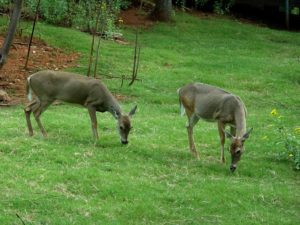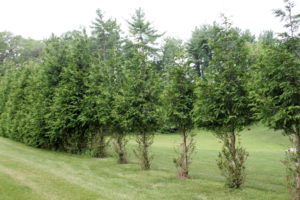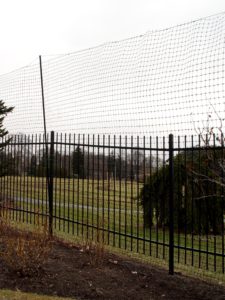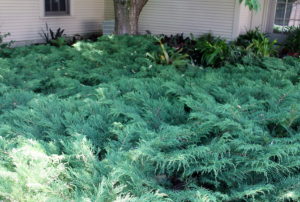What Plants Won’t Deer Eat?
August 11th, 2020
So here’s what I’ve learned after a year and a half of trying to garden up close and personal with deer.
1.) Deer are picky. That’s right. You might’ve heard (and seen) that deer will eat just about anything when they’re hungry enough. And that’s right, too.
However, deer have definite preferences for some plants over others. They start with their favorites (hosta, daylilies, tulips, eastern arborvitae, azaleas, young yews, roses, and rhododendrons, to mention a few) and then go down the list until they’re full.
On one hand, that means that nothing you plant is safe from one day becoming deer dessert. But on the other, the lower you stay on their preference list, the better shot you have at them filling up in someone else’s yard.
2.) Not all deer like the same thing. I suspect that like people, different deer have different food preferences at different times. That might explain why some people claim that deer never eat, say, panicle hydrangeas, while others say that’s the first thing they picked out in their yard.
It might also help explain why deer-resistant plant lists don’t always agree.
Different varieties or species of the same plant also seem to have enough taste or smell differences to either elevate them or lower them on the deer menu.
Rutgers University’s venerable deer-resistant plant list (which I highly recommend) bears that out in its finding that deer seldom mess with Geranium macrorrhizum, occasionally dine on Geranium sanguineum and Geranium cantabrigiense, but frequently eat Geranium endressii.
I’ve seen that in my own yard, where deer ate some varieties of my coleus but not others (at least yet).
They also ate about half of all three of my arrowwood viburnums, but they haven’t touched any of my four Korean spice viburnums (yet).
And I’ve seen deer walk by a plant for months and never touch it, only to gnaw it nearly to ground on a given night.
Maybe they just happened to be more hungry than usual when they walked by the plant that time. Or maybe the eater in question just got done thinking, “I’m sure in the mood for a good spirea tonight!”
3.) Deer preferences vary by season. This one makes good sense. Deer can fill up on fresh, tender, and tasty perennials and shrub foliage all during the growing season – flowers and veggies, too.
Things get much tougher in winter when the buffet suddenly ends. That’s when deer turn to your Hinoki cypress, that tender new cryptomeria, or the leathery, spiny leaves of evergreen hollies.
I’ve even seen deer eat rose canes – thorns and all – when there’s nothing better to eat in January.
This is why fencing and deer repellents are especially useful heading into winter. Even what you thought was “safe” could become a winter target.
4.) Deer get less picky when it’s hot and dry. Here’s another one that makes sense.
When everything’s lush and green, those picky deer fill up on their tender favorites. But when their favorites go brown or wilt or lose some flavor in the heat, the lesser rung of plants starts to look better.
I noticed that as July’s heat and dry weather took a toll on my landscape.
As things went downhill, my deer moved from the perennials and annuals to things they hadn’t touched since planting, such as a new spirea, a weigela, three dwarf panicle hydrangeas, and my two new American fringe trees.
Deer didn’t decimate them like they did the begonias, coleus, wandering jew, and annual geraniums (technically Pelargoniums), but they did chew off a fair number of branch tips and leaves. It was almost like they really weren’t enjoying it, but at least it was fresh food.
5.) Fencing and repellents work. The best way to stop deer from eating your plants (other than switching to plastic) is to fence them out.
We have lots of options on that front, from electric ones to parallel ones four feet apart, to fishing-line strands that supposedly confuse them.
I’ve had good luck (so far) with my combination of an eight-foot-tall sturdy plastic mesh fence that I ordered online from Deerbusters.com and a six-foot-tall vinyl privacy fence (the tallest my borough allows). A fawn did manage to somehow get in last week, though, but I chased him/her out before he/she could eat much.
Deer can easily jump a six-foot fence, but I think my six-footer has at least discouraged them because they can’t see what’s on the other side. I’m hoping they don’t start using periscopes or develop new nerve.
I’ve had lots of plant damage – even to fairly “deer-resistant plants” – out front where things are in the open, but no deer damage in my fence-protected back yard (yet).
My neighbors and I have also had success spraying deer repellents on plants. The trick there is keeping the spray fresh and ideally rotating brands so deer don’t get used to any one scent or taste. I’ve had good luck with a brand called Bobbex.
My neighbor went away for two weeks last month and wasn’t around to keep the deer repellent on her front-yard hostas. You can guess what happened.
Read my PennLive.com column for more on how to combat deer
6.) There are no deer-proof plants, but there are lots they hardly ever touch. Based on my own first-hand experience in lush times and lean – plus lists from Rutgers and New York’s Mohonk Mountain House – here’s a starter list of some of the garden-worthiest, deer-repugnant plants that I can recommend:
Trees: Beech, birch, black gum, dawn redwood, Japanese maple, katsura, kousa dogwood (although deer love the fruits), hawthorn, linden, redbud, sassafras, serviceberry, stewartia.
Evergreens: Boxwood, goldthread falsecypress, Japanese plum yew, Japanese umbrella pine, inkberry holly, juniper, leucothoe, pieris, pine, Russian cypress, spruce, sweetbox, western arborvitae.
Flowering shrubs: Abelia, bayberry, beautyberry, beautybush, butterfly bush, caryopteris, deutzia, forsythia, fothergilla, lilac, spicebush, red-twig dogwood, St. Johnswort, most spirea, summersweet, Virginia sweetspire, most viburnums, winterberry holly.
Perennials: Agastache, allium, amsonia, baptisia, barrenwort, betony, bleeding heart, brunnera, candytuft, catmint, coreopsis, creeping sedum, Culver’s root, euphorbia, ferns, foamflower, helleborus, iris, lamium, lavender, leadwort, ligularia, ornamental grasses, pachysandra, peony, purple coneflowers, rodgersia, Russian sage, snakeroot, salvia, sweet woodruff, yarrow, yucca.
Annuals: Ageratum, alyssum, angelonia, bidens, blue salvia, celosia, heliotrope, lantana, marigold, snapdragon, verbena, vinca, zinnia.
Bulbs: Allium, daffodil, glory-of-the-snow, Siberian squill, snowdrops.











